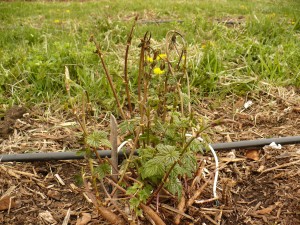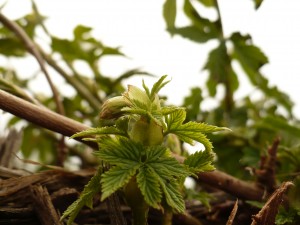Japanese beetles can be a significant economic pest in hops, so proper identification and management decision-making are important if you are going to avoid losses. Check out our article Japanese Beetles in Hops in the Northeast for more information on Japanese beetles and some control options.
Posts
NeHA Calendar of Hop Events
NeHA has released a Save the Date card of upcoming field days in New York and Vermont.
NeHA will have virus indexed stock plants available on-site at the July 21st field day at Hop Meadow Farm in Union Springs, NY. Cascade, Newport, Willamette, Perle, Fuggle, and Liberty will be available at $5 per plant in trays of 12.
Stay tuned here for more details on upcoming events!
Downy Mildew
 Downy mildew (Pseudoperonospora humuli, Miyabe and Takah., Wilson) was one of the major reasons for the decline of hops production in the Northeast over a hundred years ago. As many of you know, it is still a significant issue here, as well as in yards in the major hop growing areas of the United States and Europe. While P. humuli is closely related to the downy mildew that you can find on your watermelons, cucumbers, and zucchinis, the organism does not cross infect, meaning that you don’t have to pull out your squashes to spare your hops, or vice versa. Downy mildew can cause the complete loss of marketable yield, and even hill death in sensitive hop varieties. It is a very serious hindrance to successful hops production, but diligent integrated pest management (IPM) can help you manage the disease in your hopyard. Click here for more information on downy mildew and for best management practices concerning the disease.
Downy mildew (Pseudoperonospora humuli, Miyabe and Takah., Wilson) was one of the major reasons for the decline of hops production in the Northeast over a hundred years ago. As many of you know, it is still a significant issue here, as well as in yards in the major hop growing areas of the United States and Europe. While P. humuli is closely related to the downy mildew that you can find on your watermelons, cucumbers, and zucchinis, the organism does not cross infect, meaning that you don’t have to pull out your squashes to spare your hops, or vice versa. Downy mildew can cause the complete loss of marketable yield, and even hill death in sensitive hop varieties. It is a very serious hindrance to successful hops production, but diligent integrated pest management (IPM) can help you manage the disease in your hopyard. Click here for more information on downy mildew and for best management practices concerning the disease.
For some neat videos on pruning hops in the Pacific Northwest, and to see some of the latest research on fungicide efficacy, check out the Northwest Hop Information Network’s Facebook page.
June Scouting Report
You should be scouting in your hopyard at least once a week by this time of year, keeping an eye out for disease, pests, and any nutrient deficiencies. As you scout for insects in your hopyard, you are likely to find a thriving community. Many of the insects that you find are not a threat to your yields or to hops quality, but there are a few that are noteworthy. Last year we saw significant damage from potato leafhoppers, those pale green, wedge-shaped insects. They blow in from the south every year, arriving around the end of May, beginning of June. Scott Lewins, our resident entomologist and all around good guy, has been out scouting yards all over Vermont, and he reports that they are not only here, but that they are reproducing. You should be scouting your yard to see if they are above the threshold level of two leafhoppers per leaf, and if they are, we advise chemical intervention. For Scott’s full scouting report, please click here.
Small-scale hops baler, design 2
UVM Engineering students Yuri Hudak, John Repucci, and Ryan Rzepka have been working hard to complete a second design for a small-scale hops baler as part of their SEED (Senior Experience in Engineering Design) course. This baler is designed to create a bale of 5 lbs or less. The design shall soon be posted on our Instructional Wiki site, but in the meantime, you can check out their YouTube video in the video section of our website!
With many thanks to our funders at the Vermont Agricultural Innovation Center and the United States Department of Agriculture, Rural Development. These funds were secured through the efforts of Senator Patrick Leahy.
Frosted hops
Most of Vermont got hit by a pretty hard frost last weekend, and we’ve received numerous calls about what to do about frosted hops. In our two-year-old variety trial, Nugget in particular got a good wallop, whether that was because it isn’t as frost-tolerant as some of the varieties or because it was a little taller then the others is unknown. Things looked pretty grim across the whole yard the morning after the frost, but a few days later, it seems like most of the plants have recovered. For the varieties that were already a couple of feet tall, the frosted tips are looking brown and wilted like over-cooked asparagus.

What to do? Well, the tips of those shoots are good and dead, and they won’t continue to grow up. With the terminal buds dead, some of them are even starting to send out sidearms, which some reports say can take over as the growing point, but with reduced growth and yields as a result. In our hopyard, we’ve clipped back the shoots where the frost has nipped the tip, and the hop crown has already sent out new, undamaged growth.
For those who have a newly-planted hopyard, or have weaker crowns where only one or two shoots have emerged, I would suggest caution in trimming back the hills too much. The hop crown might be too weak to push more growth. By not trimming back the growth that has had its growing point nipped, you might lose your yield, but hopefully you won’t lose the entire hill.
While you are out in the yard, keep a sharp eye out for downy mildew spikes!

This is downy mildew making itself known: note the short internodes with down-curled leaves, particularly in comparison with the longer, leggy growth you see in the picture above. If you see these spikes, get ’em out of your yard! Other than that, we don’t really counsel removing the first flush of growth in the Northeast. In the Pacific Northwest, producers often prune the first growth, but here, our growing season is a bit shorter, and barring new data, we advise against pruning.
Small-Scale Hop Harvester and Hop Baler Designs Made Public!
We are very happy to announce that the designs for the small-scale hops harvester are now available through the UVM Extension Northwest Crops and Soils Instructional Wiki! To access the documents you will need to login and agree to the terms and conditions. We would like to encourage discussions, so please leave your comments on how the design has worked for you and any tweaks or improvements that you’ve made.
Many, many thanks to the project funders: UVM Extension; Vermont Agency of Agriculture, Foods and Markets; Massachusetts Department of Agricultural Resources; and the USDA. This project would not have been possible without the aid of Heather Darby, UVM Extension Agronomic Specialist; Rosalie Madden, UVM Extension Crops and Soils Technician; Roger Rainville, Borderview Farm; Eugene L’Etoile, Four Star Farms; Paul Hendler, Shaftsbury, VT; Trevor Lewis, Mad Mountain Hops; Mark Magiera, Bobcat Cafe and Brewery; Dave Bister, Fabrication Manager, Triangle Metal Fab; and Chris Callahan, Callahan Engineering, PLLC.
We also partnered with the UVM College of Engineering and Mathematical Sciences to design a small-scale hops baler. Seniors in the Electrical Engineering and Mechanical Engineering Programs in the School of Engineering at UVM take a year-long “capstone” course that challenges students to design and fabricate solutions to multidisciplinary problems. This unusual course is critical to preparation for the students’ post-academic world: it moves them from textbook assignments to project-driven activities typically experienced by an employed engineer; and it requires that they collaborate across typical academic boundaries and interact with working engineers.
SEED (Senior Experience in Engineering Design) is a products and systems design course. Projects originate as statements of need from regional companies, start-ups, individuals, state agencies and consumer groups, as well as faculty research groups. They are conducted by teams of students, typically three to five, with the direct, continuous involvement of the faculty as well as engineers and other professionals from partner organizations. The culmination of each project is a prototype device meant to address the stated need.
We were lucky enough to get two teams working on the baler project. Ian Pfeiffer and Brian Pinand did an excellent job completing the first prototype, and the designs for modifying a log-splitter into a small-scale hops baler are also available on the Instructional Wiki! This project was funded in part by the Vermont Agricultural Innovation Center through the United States Department of Agriculture, Rural Development. These funds were secured through the efforts of Senator Patrick Leahy.
Rhizomes!
For those of you who missed the Northeast Hop Alliance bulk rhizome purchase, there are still a few options available. Our website maintains a list of sources from where you can purchase hop rhizomes. Here is a run down of some of the local places:
Aroostook Hops, Westfield, ME has Nugget rhizomes for sale. Check out their website for pricing and availability.
Atlantic Hops still has some rhizomes available, call (917-868-6480) or email Mike for varieties and pricing.
Northeast Hop Alliance and Cornell Cooperative Extension – Live hop plants. Cascade, Fuggle, Liberty, Newport, Perle, and Willamette are being sold in 4-inch pots, and can be purchased for $5/plant, with a minimum of 30 plants/single variety. These plants are propagated from cuttings of virus-free stock purchased from the Washington State Clean Plant program. Live plant cuttings such as these are free of latent hop viruses and mildews. This is the best way to guarantee that you will start your hopyard with disease-free stock.
South Royalton Market, South Royalton, VT – Contact Scott for pricing and available varieties.
Sunnybrook Farm, Middlesex, VT – VOF certified organic hop rhizomes. Cascade, Centennial, Willamette, Kent Golding, Mt. Hood, and Magnum available for $4\each (plus shipping). Email Sunnybrook Farm, or call 802-310-6031.
Do you have rhizomes that you have harvested from your hopyard that you are interested in selling? Please feel free to post on the Vermont Hops Google Group (the group is not limited to Vermonters) or email me, and I’ll post it here.
Registration now open for the 2012 UVM Extension Winter Hops Conference!
Registration is now open for the 2012 UVM Extension Winter Hops Conference! The event will take place on March 19, 2012 at the Sheraton Hotel and Conference Center in Burlington, VT. For complete details, you can download the Winter Hops Conference flyer here.
UVM Extension 2012 Winter Hops Conference
We are very excited to announce that the 2012 UVM Extension Winter Hops Conference will take place on Monday, March 19th at the Sheraton Hotel and Conference Center in Burlington, VT. Please save the date! We have some great speakers lined up, click on link for more details.

